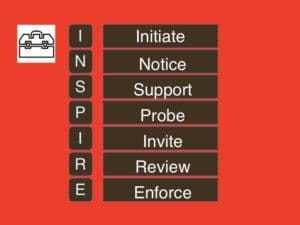Let’s be real. No one likes to hear what they’re doing wrong, particularly if they know you are right. Giving feedback is tough. Hearing tough feedback is even tougher. What do you do if they cry?
We hear this “What do I do if they cry?” question every time we teach the I.N.S.P.I.R.E. model in our tough conversations training. And we’ve had hundreds of managers confide that they’ve avoided giving needed feedback because the employee is a cryer.
Of course, if you avoid giving feedback because you can’t stand the drama, you’re making the problem worse. The behavior you need to change continues AND you’ve rewarded the crying behavior.
Some emotion is normal, but when someone regularly cries when receiving feedback (or regularly has extreme angry outbursts) it is often a defense mechanism. The unconscious reasoning goes something like this: “If I want my boss to leave me alone, I’ve just got to get a little emotional.”
What To Do if They Cry
We’re going to assume they’re not crying because you’re a jerk–that you’ve delivered the feedback carefully and are coming from a place of genuine concern to help the employee improve.
If your well-intentioned, well-delivered feedback still brings on the tears here are a few tips.
- Hand them a tissue and wait.
It’s so tempting to keep talking or abort the conversation once the tears start. But here’s the deal: either one of those will limit the other person’s growth. It’s unlikely they’re going to hear anything you’re saying when they’re that worked up. Show some empathy and give them a minute to gather themselves. If they’re still struggling to get their emotions under control, you might suggest regrouping later in the day. Either way, you want to maintain a calm neutral demeanor. Crocodile tears will dry up quickly when you do. - Use the I.N.S.P.I.R.E. model to notice the behavior (a quick example)
I (Initiate)- “I really care about you and your career and want you to be successful”
N (Notice)- “I’ve Noticed you get emotional whenever we have a feedback discussion.”
S (Support) “For example, in our last one-on-one you cried, and now you’re getting upset again.”
P (Probe) “What’s going on?” (linger here)
I (Invite) “What do you think you could do to be able to engage in these conversations in a more productive way?”
R (Review) “Oh, I think that’s a great idea”
E (Enforce) “So let’s debrief our next feedback conversation next week and talk about how those new strategies went.” - Keep your cool.
Emotions can be contagious. As a leader, it’s important that you keep the conversation in perspective. You’re giving them feedback because you care and want to help. Their reaction is not about you. Don’t take it personally. Calm, neutral, and curious is your mantra. - Check for understanding.
When people are in an emotional state it’s more important than ever to ensure they’ve heard you. Once they’ve calmed down ask them to recap what they’ve heard and what they’re committing to do differently (Review), and set up a time to connect again to assess progress (Enforce).

